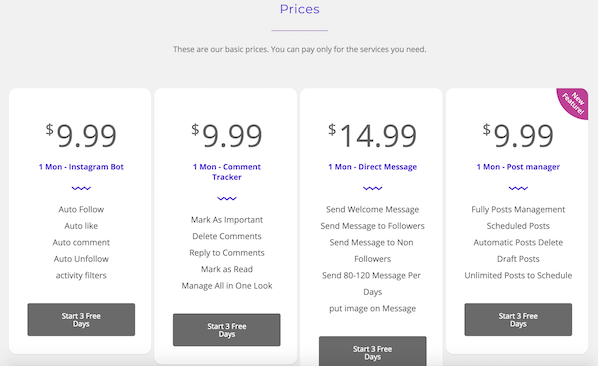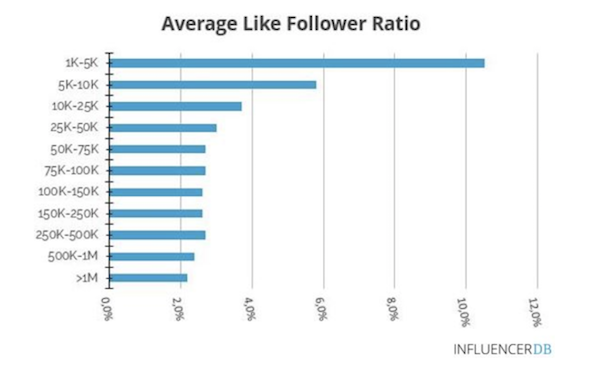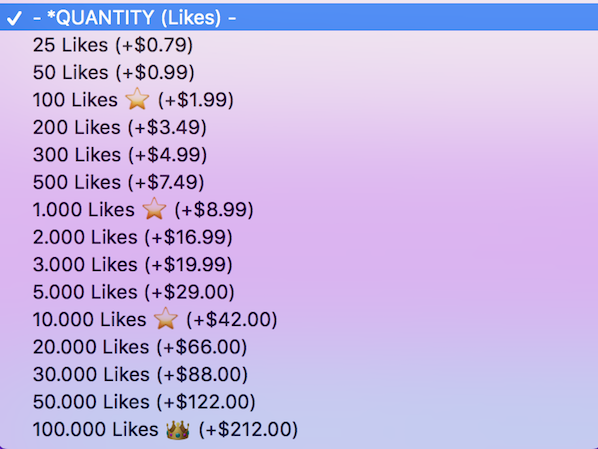You can see the pricing is fair ($66 for 20,000 likes), but, in the long haul, it’s not a sustainable or reputable marketing tactic.
2. Buy Instagram Bots to Follow Other People’s Accounts
There’s an unwritten “I follow you, you follow me” rule that exists on Instagram, which basically means if someone follows me, I feel obligated to follow them in return. Many people feel the same way when following other accounts on Twitter. And it’s the premise of this second method.
With this service, you’re essentially buying a bot to follow other people’s accounts, with the hope that these accounts will follow and like your posts in return. The bot basically acts as an invisible minion, following accounts from your profile and liking and commenting on posts as if it were you.
After these Instagram bots follow a bunch of accounts, they’ll eventually unfollow them, to ensure you have a better follow-to-follower ratio.
This method shares the same risky and long-term complications as the buying likes from fake accounts tactic, but there are additional dangers to using a bot. For one, the bot only knows how to “auto comment” and “auto like.” Your bot, acting as you, is not a real person and can’t understand various nuances that exist in language, which could lead to PR-related misshaps when you realize your bot engages with an account that posts inappropriate content.
For instance, the bot might start liking any posts with hashtags that you’ve programmed it to like. This could cause your bot to like irrelevant posts that don’t support your brand’s values, or even hateful accounts that post content your customers would find offensive.
Even worse, if the bot is “auto commenting” for you, it might misconstrue a post’s intent: for instance, if the word “happy” is in someone’s post about their beloved pet who recently passed away, the bot might comment, “That’s awesome, congrats!”
Below is an example of a service, Instazood, that provides bots for as little as $10. (Low price, high risk, am I right?)

There are other services to buy Instagram likes, but ultimately, you shouldn’t trust a bot or fake accounts to receive authentic engagement.
The Three Biggest Reasons Buying Instagram Likes is a Bad Idea
Besides the hazards I just mentioned, there are three big-picture problems with buying Instagram likes regardless of the service.
First, Instagram might deactivate your account if they suspect you’re not using honest methods to build a following and attract engagement. Since 2014, Instagram has been hunting for and deactivating millions of fake accounts on Instagram, and paying for likes goes against Instagram’s Community Guidelines. They want their platform to remain a place for authentic connections, and so should you.
Second, it’s not a sustainable marketing strategy: ultimately, your long-term goals should revolve around creating deep, meaningful relationships with your audience, turning this audience into real-life customers, and creating a customer service process to ensure these customers become brand advocates.
None of these outputs will come to fruition if your likes are from fake accounts.
Lastly, buying Instagram likes can actually hurt your engagement ratio. Instagram doesn’t measure how many likes each post gets. Rather, it measures how many likes each post gets in relation to how many followers you have.
This means if your posts start receiving 10,000 likes, but you only have 1,000 followers, your posts are going to be seen by fewer people, and are less likely to get discovered.
Here’s a graph from InfluencerDB to illustrate the like-to-follower ratio:

Ultimately, buying likes in an effort to increase engagement can actually decrease engagement, destroying the one thing you’re trying to get. Ironic, I know. So skip the shady shortcut to social media marketing, and use a more long-term but sustainable plan for attracting organic likes from real people. After all, those real people are the only ones who can become real customers.



